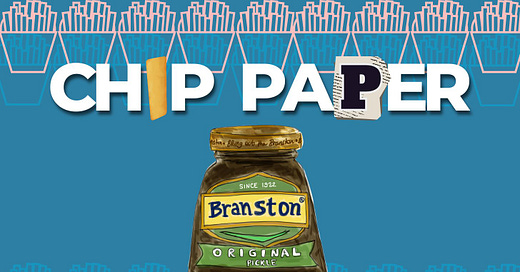Condiment Curiosity: Branston Pickle
"Bring Out The Branston" is the iconic tag line, but before we bring it out let's rewind to find out how this tangy veg pickle - a post-WW1 creation - came about and how it's endured a century so far
Did you know Branston Pickle is named after a real town? Or that it was once made in a machine gun factory? Or that its range has expanded to include Branston mayonnaise, baked beans and even its own version of brown sauce to rival HP?
It may be the Marmite of chunky accompaniments but love it or loathe it, there’s no doubt Branston Pickle levels up any form of cheese sandwich, toasted or not. A board of cold cuts and cheeses at Christmas feels incomplete without the sweet, crunchy tang of Branston. The Ploughman’s lunch first appeared in the mid-Fifties and since then how could you have a Ploughman’s, either sandwich or plate, without Branston Pickle?
100 and one years ago, Branston Pickle first came off the line and today it’s estimated that 17 million jars are sold in the UK annually; it has been said often that “one in three households” in the UK buy Branston Pickle regularly. But how did this like-it-or-lump-it condiment endure through the last century and into this one, from post-World War I beginnings to the modern conveniences of today? Let’s deep dive into this dark, sharp and knobbly little spread…
Origins of Branston Pickle: A Placename which Stuck, but a Company which Didn’t
It’s 1917, the latter part of World War I, and the British government decide to locate a national machine gun factory in the small town of Branston in Staffordshire. However, the war concludes in late 1918 before the building’s construction is finished. With the site now no longer needed and lying vacant, the government invites bids to buy it. First, a car company puts in a bid and is rejected for being too low. Then, a successful food manufacturing company called Crosse & Blackwell put in a sealed bid for the building - £600k in old money, which equates to around £34.2m today - and that bid was accepted.
There’s a slight delay with the paperwork so it’s actually not until 1921, three years later, when the sale is properly finalised and Crosse & Blackwell get the keys. The company packs up their current location in London’s Soho to re-locate three hours away to Branston where soon enough they begin production. This is a very established company already so they produce a wide variety of products, but to mark their new location and company growth they decide to begin producing a new product which bears the name of the town the factory is based in. In 1922 Branston Pickle is born.
However, the recipe is not necessarily linked to this factory. The company also purchased another site in the same town at the same time, Branston Lodge, as a residence for the female workers of the company. It’s here that the original recipe is developed - attributed to a ‘Mrs Caroline Graham’ and her daughters ‘Evelyn’ and ‘Ermentrude’ - though it is in the larger factory in the town where this recipe is scaled and mass-produced. It’s believed that the recipe to this day is still the same.
How fabulous, right? Post-War, a huge new facility arrives to a small, seemingly insignificant town outside Burton-upon-Trent and signals the makings of the place. Branston firmly on the map, and little may the locals have known it would become a household staple for the next century. However, even though it may seem C&B were the makings of the town of Branston, providing jobs, houses and even naming a product after the town, all was not going financially well.
Less than two years into production and the new, state of the art factory was becoming unviable. In 1924 production was already beginning to wind down and by January 1925 it had entirely ceased, the company moving all production back to London, resulting in the loss of many jobs and stirring a local resentment for the company. In fact, their products - including Branston Pickle - were boycotted by Branston locals for many years.
But Branston Pickle wasn’t going anywhere.
Keep reading with a 7-day free trial
Subscribe to Chip Paper to keep reading this post and get 7 days of free access to the full post archives.





